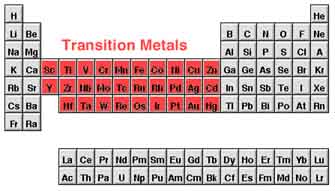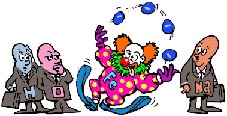The Transition Metals
 So all the elements are arranged in columns according to how many valence
electrons they have, and that tells you what they do in chemical reactions.
So all the elements are arranged in columns according to how many valence
electrons they have, and that tells you what they do in chemical reactions.
 Right--except it's not always quite that simple. So far I've been avoiding
the elements in the middle of the periodic table, called the transition
metals...
Right--except it's not always quite that simple. So far I've been avoiding
the elements in the middle of the periodic table, called the transition
metals...
|
 Tell me about them.
Tell me about them.
|

 At first sight, they look like a confusing and irritating break in the
pattern. For one thing, they can't be divided neatly into groups;
all of them have very similar properties. Also, unlike the
elements we've been talking about, they don't always use the same number
of valence electrons in chemical reactions. Iron (Fe), for example, sometimes likes to give
away two electrons, and sometimes three.
At first sight, they look like a confusing and irritating break in the
pattern. For one thing, they can't be divided neatly into groups;
all of them have very similar properties. Also, unlike the
elements we've been talking about, they don't always use the same number
of valence electrons in chemical reactions. Iron (Fe), for example, sometimes likes to give
away two electrons, and sometimes three.

 Why are they so weird?
Why are they so weird?
|
 You tell me. Look at the applet; what's going on with the electrons in
the transition metals?
You tell me. Look at the applet; what's going on with the electrons in
the transition metals?
|
 Well, those ten elements fill up the ten 3d orbitals. But the 4s orbitals
already have electrons in them before you get to the transition metals--a
higher sublevel got filled first.
Well, those ten elements fill up the ten 3d orbitals. But the 4s orbitals
already have electrons in them before you get to the transition metals--a
higher sublevel got filled first.
|
 I can tell you why that happens...
I can tell you why that happens...
|
 The result is that all the transition metals
have the same arrangement of outer electrons; only the 3d orbitals,
lower down, are different.
The result is that all the transition metals
have the same arrangement of outer electrons; only the 3d orbitals,
lower down, are different.
 And that's why all the transition metals are so much alike!
And that's why all the transition metals are so much alike!
 Exactly. You can also see why they might keep changing their minds about
how many valence electrons they have. Iron sometimes gives up just its
two 4s electrons, and sometimes throws in a 3d, since those are so close
in energy.
Exactly. You can also see why they might keep changing their minds about
how many valence electrons they have. Iron sometimes gives up just its
two 4s electrons, and sometimes throws in a 3d, since those are so close
in energy.






